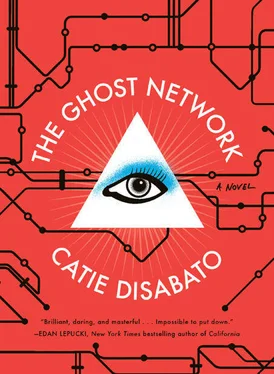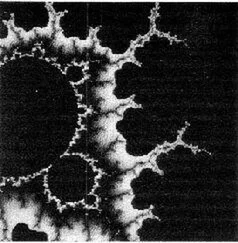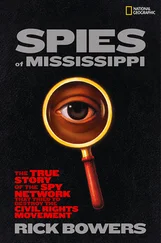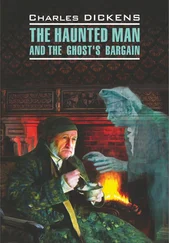“Maybe she was trying to protect you,” Berliner said to Nix.
“Oh yeah,” Nix said sarcastically, raising her hand with two fingers missing, “she did a really good job protecting me. I’m literally scarred for life.”
Berliner didn’t respond.
Nix said, “Can we stop fucking around and just tell him Taer’s story about her Special Secret Investigation of the Secret Pink Dot now?”
“Please do,” I responded, before Berliner could say anything.
That day, Taer told Berliner and Nix she was picking up an extra shift at Rainbo. At about 3 p.m., Taer left the Urban Planning Committee headquarters and rode the Metra Union Pacific Northwest Line to the location of the second pink dot. †
Taer searched the outermost boarder of the grounds of the Chicago Executive Airport for a full hour. She couldn’t wander the grounds because a security guard chased her off when she tried, but luckily, she didn’t need to go deep into the airfield to find what she was looking for. Just south of the small terminal, near a stretch of runway running alongside South Milwaukee Avenue, Taer found a small brick building painted almost the same color pink as the dots on the digital version of The Ghost Network. The pink paint, though chipped, stood out against the bleak airport landscape of gray and faded green. Taer stood on the hood of someone’s car, smashed through one of the windows with a branch, cut through a flimsy wire screen with the sharp side of one of her keys, and heaved herself over the window ledge.
Immediately, Taer looked for a staircase to the basement and found another steel door with a little keypad lock. She entered the same combination she used to enter the Urban Planning Committee headquarters and the door opened. She descended into darkness.
Taking pictures with her phone as she went, Taer descended on stairs made of rotting wood. She kept one hand on the brick wall to steady herself, and in the other held her cell phone, with her flashlight app activated. Just before she reached the bottom of the staircase, the stairs changed to concrete and tile. Her hand, moving blindly along the wall, bumped into a light switch. She flicked it, and with a loud hum, the lights turned on. Taer was in a train station in disrepair, decorated with signage from the 1950s, plaques that said in fat, black letters “NO SMOKING. NO SPITTING” and “WATCH OUT: DO NOT LEAN OVER THE PLATFORM.” She kicked up clouds of dust and she walked across the floor of cracked tile, arranged in a formless white and green mosaic. Coughing from the dust, lighting her way and taking pictures, Taer found a single incongruous item: a plaque made of plastic, lightly backlit by an LED lamp, designed to look like one of the ’50s plaques, but which clearly had been affixed to the wall of the station more recently. It said “PLAQUES TOURNANTES TROIS” in the same black lettering.
Taer only spent a minute or two exploring the station before a dim beam of light suddenly broke the darkness, emanating from the tunnel beyond. She froze, then scrambled out of the pathway of the light. She waited. The light intensified quickly, and she heard the screech and chug of an approaching train. Had Taer stayed, all her mysteries would’ve been solved, but she was terrified. She ran.
On the long ride from the airport back to the Urban Planning Committee headquarters, during which she anxiously transferred between Metra trains and L trains and buses in case someone was following her, Taer tried to call Nix and Berliner several times. Neither of them answered their phones. Taer’s mind reeled with the memory of the unknown train’s bright light, and she spent about an hour in a coffee shop near the headquarters, writing furiously in her journal. Her notes from this writing session were penned so sloppily as to be almost unreadable. As if she was trying to get her hand to move as fast as her racing mind, she neglected to finish sentences and ignored the lines on the paper. As she wrote page after page, she returned several times to a single thought, first expressed as: “I bet Molly got on that train.” By the end of the hour, she had dropped all speculation: “Molly got on that train.”
Taer walked to the headquarters still dazed, where she was surprised to find Berliner in his kitchen, icing a fresh wound on the back of his head. While he and Nix were walking through an alley shortcut between the Urban Planning Committee headquarters and the nearest liquor store, someone jumped them from behind and knocked Berliner unconscious. When he came to, Nix was gone.
Taer panicked. She called Nix’s cell phone about fifty times; Nix never answered. Eventually, the phone stopped ringing and went straight to Nix’s voice mail. Crying in fear and frustration, Taer wanted to call the police and report Nix missing, but Berliner stopped her. He had a different way to help Nix, which involved revealing a secret he’d been keeping from Taer since she had found him.
Because Berliner knew how important Molly’s pop star career was to her and her ideals, when Molly didn’t show up for the sound check on January 9, Berliner immediately assumed she had been taken against her will. He believed nothing would’ve made Molly Metropolis give up her position of power.
Berliner suspected Ali and Peaches had kidnapped her. He stole his grandmother’s gun and quickly found the New Society in a downtown apartment that Zavos owned, on the seventh floor of the Anne De Zoet building in a posh area of Chicago called River North. While Nix frantically searched through boutique clothing stores and Molly’s dancers rehearsed during sound check without her, Berliner stormed the headquarters of the Society of Children of the Atomic Bomb.
Actually, “storming” isn’t the right word to describe Berliner’s actions. It’s not as though he burst through the doors of the apartment complex with a double-barreled shotgun in his arms and a S.W.A.T. team at his back. The doorman, Ray Mitchell, opened the door for him and called up to number seven to see if Ali was in. She told Ray to send Berliner up. Berliner allowed the doorman to put his coat, with his gun and his map sketchpad in the pocket, in the apartment complex’s coat check, where he assumed his items would be safe. He was worried that if he brought them up to the apartment, Ali, Peaches, and their compatriots would overpower him and take them.
Peaches greeted Berliner at the door, checked him for weapons or papers and, finding nothing, invited him inside. Berliner noticed the wooden flooring and the chic, minimalist furnishings and décor. He sat in the living room on a brown leather sofa, a seat which afforded him a great view of the downtown skyline. One of the younger members of the New Society brought them glasses of white wine, then lingered in the corner during Peaches and Berliner’s conversation. Berliner never saw a New Society member older than Ali; they gave the collective impression of malleable young cult members.
Berliner declined to drink the wine and refused to stay on the couch. He believed Molly was tied up in a closet somewhere. Peaches allowed him to go through every nook and cranny of the apartment. He spent a full hour searching, even looking for secret panic rooms (and later he acquired blueprints from the city, the building’s management, and the building’s security company to make sure he hadn’t missed anything). No Molly to be found.
Instead, resting on a nightstand in the fourth bedroom, he saw the circular purple quartz necklace Davis always wore. This discovery rattled Berliner; he didn’t want to believe that a woman he’d trusted had betrayed him so thoroughly. He decided not to mention his discovery to the New Society and test Davis’s loyalty at another time — a test that, as previously described, ultimately led to Taer’s involvement in his investigation of Molly’s disappearance.
Читать дальше












